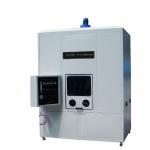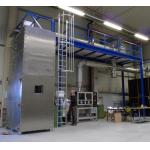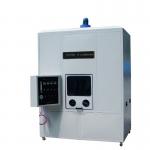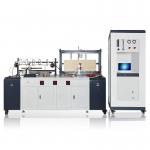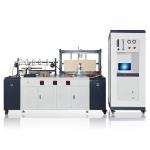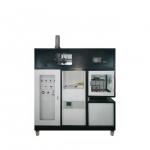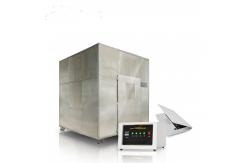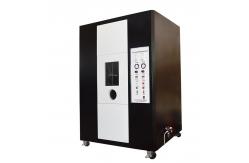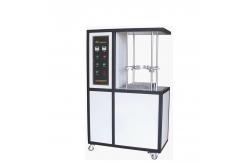In the aerospace and automotive sectors, where safety and
reliability are non-negotiable, the accurate assessment of fire
performance is of utmost importance. The Customized Fire
Performance Testing Devices for Aerospace and Automotive Industries
are engineered to meet the stringent demands and unique challenges
of these high-tech fields. These state-of-the-art testing devices are designed to evaluate the
fire resistance and reaction-to-fire characteristics of a wide
array of materials and components used in aerospace and automotive
applications. From lightweight composites and advanced alloys in
aerospace to plastics, upholstery, and wiring harnesses in
automotive, their primary purpose is to determine critical
parameters such as ignition temperature, flame spread rate, heat
release rate, smoke and toxic gas production, and the ability of
materials and systems to maintain functionality and integrity under
extreme fire conditions. This data is essential for manufacturers,
research institutions, and regulatory bodies to ensure compliance
with industry-specific safety standards, drive innovation in
material and product design, and safeguard the lives of passengers
and crew. - Robust and Heat-Resistant Build Quality
- The testing devices are constructed with high-strength,
heat-resistant materials. The framework is often made of
aerospace-grade alloys or heavy-duty steel, capable of withstanding
the intense thermal and mechanical stresses associated with fire
testing. The interior chambers and test compartments are lined with
advanced refractory ceramics or high-temperature composites, able
to endure temperatures exceeding 2000°C. Access doors and viewing
ports are crafted from multiple layers of heat-strengthened glass
and hermetic seals, ensuring a secure and controlled testing
environment. The overall design is optimized to minimize heat loss
and maximize the accuracy of test results while providing maximum
safety for operators.
- Precision Temperature and Flame Control
- Temperature Control: These devices offer highly precise temperature
regulation, ranging from ambient to 1800°C, with an accuracy of
±1°C. They employ advanced heating elements, such as graphite or
molybdenum disilicide heaters, combined with a sophisticated PID
(Proportional-Integral-Derivative) control algorithm. Multiple
thermocouples are strategically placed to ensure uniform
temperature distribution and rapid response to any temperature
fluctuations. The control interface allows for the programming of
complex temperature profiles, including rapid ramping, precise
holding, and cyclic temperature patterns, to replicate the diverse
and severe temperature changes that occur in aerospace and
automotive fire scenarios.
- Flame Generation and Control: The flame generation and control
mechanisms are highly customizable. They can produce flames with
adjustable intensities, from a gentle pilot flame to a powerful,
high-temperature jet flame. The fuel supply, which can include
specialized aviation or automotive fuels, is precisely metered
using ultra-precise flow regulators. The air-fuel ratio can be
adjusted within a broad range, allowing for the creation of flames
with different combustion characteristics. This flexibility is
crucial for testing the response of materials and components to
various types of flames, such as the slow-burning flames of a
smoldering fire or the intense, high-velocity flames encountered in
fuel system failures or post-crash fires.
- Advanced Instrumentation and Data Acquisition
- The devices are equipped with a comprehensive suite of sensors and
measurement devices. In addition to highly accurate temperature and
flame sensors, they incorporate optical sensors for detailed
monitoring of flame characteristics, including flame height,
luminosity, color temperature, and spectral analysis. Smoke density
sensors, based on advanced light scattering and absorption
technologies, can accurately measure the concentration and particle
size distribution of smoke. Gas sensors are designed to detect and
analyze the composition of gases emitted during combustion,
including toxic gases like carbon monoxide, hydrogen cyanide, and
volatile organic compounds specific to aerospace and automotive
materials. These sensors are interfaced with a high-speed,
multi-channel data acquisition system that records and stores all
relevant data. The data acquisition system offers an impressive
sampling rate, often exceeding 15,000 samples per second, ensuring
that even the most rapid and minute changes in fire behavior are
captured. The collected data can be analyzed in real-time or
retrieved later for in-depth studies using specialized software,
which provides detailed reports and graphical representations of
the test results.
- Versatile Testing Modes and Configurations
- The testing devices offer a wide variety of testing modes and
configurations to meet the specific requirements of the aerospace
and automotive industries. They can perform horizontal and vertical
flame spread tests on materials such as upholstery fabrics,
plastics, and composites used in vehicle interiors and aircraft
cabins. Cone calorimeter tests can be carried out to measure the
heat release rate and other combustion parameters of samples under
a controlled radiant heat flux, simulating the heat exposure in a
fire. Additionally, they can be configured for fire resistance
tests of critical components like fuel tanks, wiring harnesses, and
engine compartments. The devices can also be integrated with other
environmental control systems, such as pressure and oxygen
concentration control, to replicate the specific conditions
encountered in high-altitude flights or confined automotive spaces.
This versatility makes it suitable for testing a vast range of
materials and components, from lightweight aerospace alloys to
advanced automotive polymers.
- Stringent Compliance with Industry Standards
- The Customized Fire Performance Testing Devices are meticulously
designed to comply with a comprehensive set of international and
national standards specific to the aerospace and automotive
industries. They adhere to standards such as FAR (Federal Aviation
Regulations) and SAE (Society of Automotive Engineers) standards
for fire testing. For example, they meet the requirements for
testing the fire resistance of aircraft cabin materials and
components, including seat cushions, wall panels, and overhead
bins. In the automotive industry, they comply with standards for
testing the flammability of interior materials, the fire resistance
of fuel systems, and the integrity of electrical components under
fire conditions. This compliance ensures that the test results are
widely recognized and accepted by regulatory authorities and
industry peers, facilitating product certification and market
entry.
- Chamber Size and Capacity
- The devices are available in different chamber sizes to accommodate
various sample sizes and testing volumes. Smaller chambers may have
interior dimensions of 0.3 meters x 0.3 meters x 0.3 meters,
suitable for testing small components or specimens like individual
wiring connectors or samples of cabin trim materials. Medium-sized
chambers can measure 0.6 meters x 0.6 meters x 0.6 meters,
providing sufficient space for testing larger components such as
fuel pump assemblies or seat frames. Larger chambers, with
dimensions exceeding 1 meter x 1 meter x 1 meter, are ideal for
full-scale testing of entire systems or large sections of aircraft
or vehicle interiors. The interior volume and shape are carefully
optimized to ensure proper air circulation and uniform exposure of
the sample to the fire and environmental conditions.
- Temperature Range and Accuracy
- As mentioned earlier, the temperature can be controlled from
ambient to 1800°C, with an accuracy of ±1°C. The temperature ramp
rate can be adjusted from 0.5°C per minute to 200°C per minute,
allowing for the simulation of both slow and extremely rapid
temperature changes. For instance, a rapid ramp rate can mimic the
sudden heat increase during a fuel explosion or a high-energy
impact-induced fire in an aerospace or automotive accident.
- Flame Intensity and Control Parameters
- The flame intensity can be adjusted over a wide spectrum, with a
maximum heat output equivalent to several megawatts per square
meter. The fuel flow rate can be varied from a few milliliters per
minute to several liters per minute, and the air-fuel ratio can be
precisely controlled within a range of 1:0.5 to 20:1. These
parameters enable the creation of flames with different
characteristics, from a small, stable flame for precision testing
to a large, turbulent flame for more severe fire simulations. The
device also allows for the control of flame duration and the number
of ignition sources, providing further flexibility in testing
different fire scenarios.
- Data Acquisition Rate and Resolution
- The data acquisition system samples sensor data at a rate of 15,000
samples per second. The temperature sensor has a resolution of
0.1°C, the smoke density sensor can detect changes as small as
0.001% opacity, and the gas sensors have a sensitivity in the parts
per million (ppm) range for most common gases. This high-resolution
and high-speed data capture ensure that the device provides
detailed and accurate information about the fire performance
characteristics of the tested samples and components, enabling
in-depth analysis and interpretation of the test results.
- Compliance with Key Industry Fire Testing Standards
- The device complies with FAR and SAE standards relevant to fire
testing in the aerospace and automotive industries. It can also be
customized to meet specific requirements of other industry
standards or regulatory codes, ensuring its adaptability to
different applications and emerging safety regulations. For
example, it can be configured to meet the evolving standards for
testing the fire safety of electric vehicle batteries and their
associated systems.
- Accurate Simulation of Fire Scenarios
- The primary function of the devices is to provide a highly accurate
and realistic simulation of fire conditions specific to the
aerospace and automotive industries. By precisely controlling
temperature, flame characteristics, and other environmental
factors, they allow for the comprehensive evaluation of how
materials and components will perform in actual fire situations.
For example, they can determine if an aircraft cabin material will
release toxic gases that could endanger passengers, if a fuel tank
will rupture and cause a catastrophic fire, or if an automotive
wiring harness will maintain its integrity and functionality under
fire exposure. This information is invaluable for engineers and
designers to make informed decisions and develop safer and more
fire-resistant products.
- Enhanced Product Development and Quality Assurance
- Through detailed fire performance testing, manufacturers in the
aerospace and automotive sectors can identify and address potential
fire safety issues in their products at an early stage. If a
material shows a high flame spread rate or excessive smoke and
toxic gas production, appropriate modifications can be made, such
as using fire retardants, changing the material composition, or
improving the design of components. This leads to the development
of higher-quality and more reliable products that meet or exceed
the strict fire safety standards of these industries. The devices
also serve as a crucial part of quality control, ensuring that each
batch of products is tested and compliant, thereby reducing the
risk of product recalls and enhancing brand reputation.
- Facilitation of Regulatory Compliance and Certification
- Regulatory bodies in the aerospace and automotive industries rely
on accurate and standardized fire performance test results to
enforce safety regulations. The Customized Fire Performance Testing
Devices enable manufacturers to conduct tests in accordance with
recognized industry standards, providing the necessary data for
regulatory compliance and product certification. This helps in
streamlining the approval process, ensuring that products can be
legally marketed and used in aerospace and automotive applications,
ultimately protecting the safety of passengers and crew.
- Stringent Manufacturing Process
- The fire performance testing devices for the aerospace and
automotive industries are manufactured under strict quality control
procedures. Each component, from the heating elements and sensors
to the control panel and chamber lining, is carefully sourced and
inspected for quality and performance. The assembly process is
carried out by highly trained technicians in a clean and controlled
environment. The devices undergo a series of calibration and
validation tests during the manufacturing process to ensure that
they meet the required accuracy and performance standards.
- The calibration of temperature, flame, and other sensors is a
critical part of the manufacturing process. It is performed using
traceable reference standards that are calibrated to the highest
levels of accuracy, guaranteeing the reproducibility of the test
results. Rigorous quality audits and inspections are conducted at
various stages of production to maintain the highest level of
product quality and compliance with industry-specific fire
performance testing standards.
- Quality Certification and Validation
Our devices have obtained relevant quality certifications and have
been validated by independent aerospace and automotive fire testing
laboratories. They have been proven to provide accurate and
reliable test results, conforming to the relevant industry
standards. We also continuously update and improve our product
based on the latest technological advancements and customer
feedback from the aerospace, automotive, and fire safety industries
to ensure its long-term performance and compliance.
- Aerospace Industry
- An aerospace manufacturer used the Customized Fire Performance
Testing Devices to test a new type of composite material for use in
aircraft wings. The tests revealed that the material had excellent
fire resistance, with a low flame spread rate and minimal smoke
production. This enabled the company to use the material in their
next-generation aircraft design, reducing the overall weight of the
aircraft while maintaining fire safety, which is crucial for fuel
efficiency and flight performance.
- A research institution tested the fire performance of different
insulation materials for aircraft engines. The results showed that
one particular insulation material had a higher heat release rate
than expected, which could pose a risk to the engine and
surrounding components in case of a fire. By switching to an
alternative insulation material and retesting, they were able to
ensure the fire safety of the engine compartment and improve the
overall reliability of the aircraft.
- Automotive Industry
- An automotive company tested the flammability of different
upholstery fabrics for their new car models. The testing identified
that a certain fabric had a rapid flame spread and emitted a large
amount of smoke. By using a fire-retardant-treated fabric and
testing it again, they were able to improve the fire safety of the
vehicle interiors and meet the regulatory requirements.
- A manufacturer of electric vehicles tested the fire behavior of
their battery packs. The Customized Fire Performance Testing
Devices allowed them to simulate different types of battery failure
scenarios and evaluate the effectiveness of their fire suppression
systems. The results helped them optimize the design of the battery
packs and improve the overall fire safety of their electric
vehicles, addressing one of the major concerns in the emerging
electric vehicle market.
- Pre-Sales Technical Consultation
Our team of aerospace and automotive fire safety experts provides
in-depth technical consultations to help customers understand the
capabilities and suitability of the Customized Fire Performance
Testing Devices for their specific testing needs. We offer
demonstrations and training, tailored to the industries, to
familiarize customers with the operation and functionality of the
devices before purchase. We also assist in selecting the
appropriate test methods and accessories based on the materials or
components to be tested. - After-Sales Service and Maintenance
We offer comprehensive after-sales service, including on-site
installation and commissioning. Our technicians are available for
regular maintenance, calibration, and emergency repairs. We provide
spare parts and upgrades to keep the test devices operating at peak
performance. We also offer service contracts that include
preventive maintenance and priority technical support, ensuring the
long-term reliability and availability of the devices for fire
performance testing in the aerospace and automotive industries. - Training and Technical Support
We conduct training programs for new users to ensure they can
effectively operate the Customized Fire Performance Testing Devices
and interpret the test results. Our technical support team is
available 24/7 to answer questions, provide troubleshooting
assistance, and offer guidance on test method optimization and
compliance with industry-specific fire performance testing
standards. We also provide software updates and support for the
data acquisition and analysis systems, enabling customers to take
full advantage of the latest features and technologies in fire
performance testing for these sectors.
The Customized Fire Performance Testing Devices for Aerospace and
Automotive Industries are an essential asset for any organization
involved in the design, development, and manufacturing of aerospace
and automotive products. If you are looking to enhance your fire
performance testing capabilities, ensure compliance with industry
standards, or drive innovation in fire safety, this is the ideal
solution. Contact us today to learn more and get a customized
quotation. Let us help you unlock the full potential of your fire
performance testing and product quality assurance in the aerospace
and automotive fields. |
